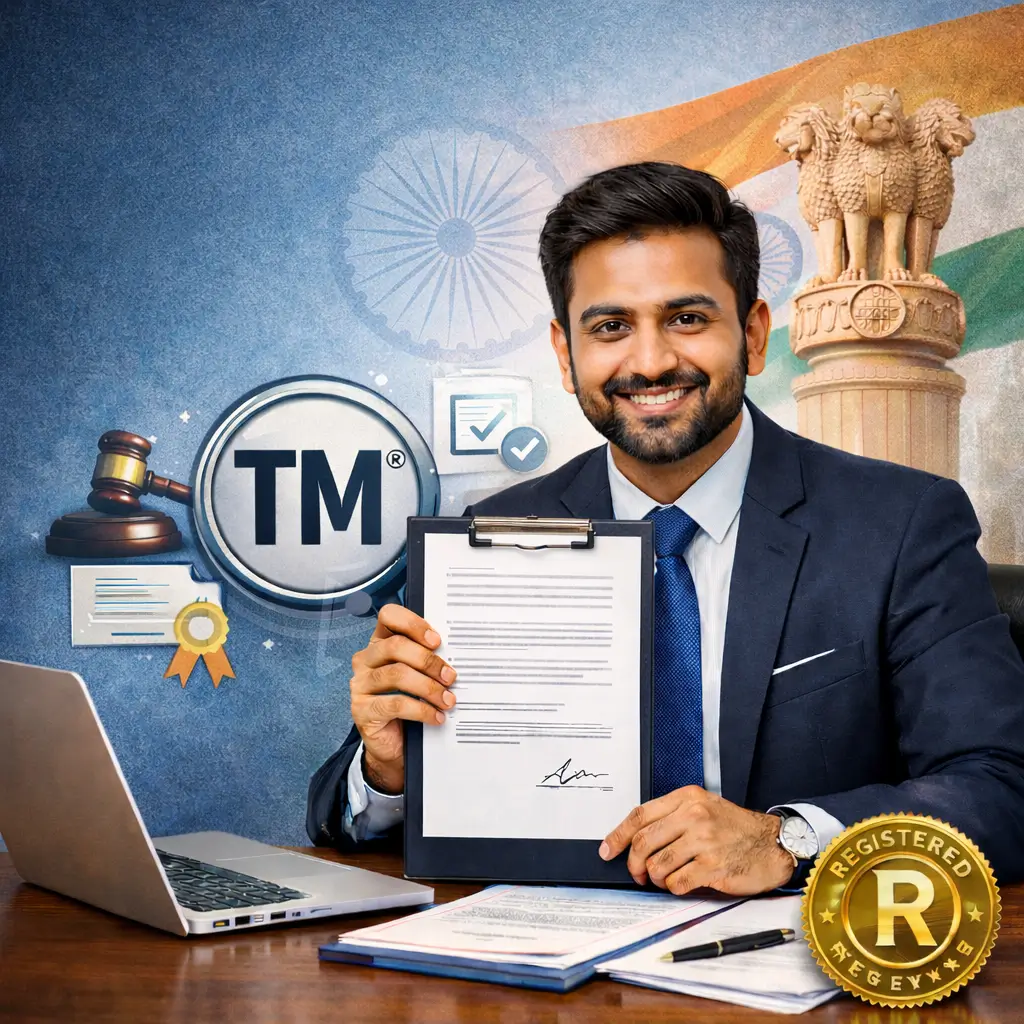Apply for Trademark Registration
Don’t let others copy your brand. Get fast and reliable trademark registration in India with our professional support. We simplify the entire process and ensure complete compliance. Apply now and protect your business identity before it’s too late. Talk to our experts today and get started instantly.

- 12000+ Customers served
- 75% Customers recommend us
- 4.8+ Google Rating
Trademark Registration in India
In today’s competitive business world, building a strong brand is just as important as offering good products or services. Your brand name, logo, slogan, or symbol helps customers recognize and trust your business. To protect this identity legally, trademark registration in India is essential.
What Is a Trademark?
A trademark is a unique sign, word, logo, symbol, design, or phrase that distinguishes your business from others. It represents your brand identity in the market.
Examples of trademarks include:
- Brand names
- Logos
- Taglines or slogans
- Symbols
- Product names
- Packaging designs (in some cases)
Once registered, a trademark gives you legal ownership and exclusive rights to use it.
Why Is Trademark Registration Important?
Many business owners use logos and brand names without realizing that without trademark registration, they don’t fully own the rights to those assets. Here’s why registering your trademark is important:
1. Legal Protection
Once registered, you gain the exclusive right to use the trademark in connection with your goods or services. If someone copies your brand or logo, you can take legal action against them.
2. Brand Value
A registered trademark increases your brand’s value. If you ever plan to sell your business, having a trademark can make it more attractive to buyers.
3. Exclusive Rights
You get the exclusive right to use your trademark nationwide, which prevents others from copying or misusing your brand.
4. Nationwide Rights
In many countries like the United States or India, registration gives you legal rights across the entire country—not just your local area.
Fees and Required Documents for Trademark Registration
Trademark Registration Fees
(Professional Fee ₹ 1999 + Govt Fee:₹4500)
₹
6500/-
- Trademark Availability Search
- Drafting of User Affidavit
- Filing of Trademark Application
Pay Now
(Secured by Razorpay)
(Secured by Razorpay)
Note – Above Fee Does not include Objection and Hearing Fees (if any)
Documents Required For Trademark Registration
- Applicant/ Authorised Signatory Name
- Applicant/ Authorised Signatory Father Name
- Applicant/ Authorised Signatory Address
- Name of Company (if any)
- MSME Registration Certificate (If any)
- Trademark Logo in Jpeg Format (If any)
- List of Products or services
- Trademark Class
- Company Email ID and Mobile number
Word Mark
A word mark uses only words, letters, or numbers to represent a brand, without any design
Example:
"TATA", "AMUL", or "AIRTEL"
Device Mark (Logo)
A device mark is a logo or symbol that represents a brand visually.
Example:
Nike’s swoosh, Apple’s apple logo
Punchline or Slogan
A short, catchy phrase that represents the brand’s message.
Example:
“Just Do It” (Nike), “Daag Acche Hain” (Surf Excel)
Brand Name
A brand name is the name used to identify a company’s products or services. It can be protected as a trademark.
Example:
Pepsi, Samsung, Zomato
Domain Name
A domain name is a website name that identifies a brand online and can be trademarked if unique.
Example:
flipkart.com, amazon.in
Sound Mark
A sound mark protects a unique sound or tune linked to a brand that people recognize by hearing.
Example:
Yahoo! yodel, Intel chime
Explore Trademark Classes
In India, trademarks are classified into various categories based on the type of goods and services they represent. This classification system is known as the Nice Classification, established by the Nice Agreement (1957), and is used internationally. In India, this system is adopted and managed by the Office of the Controller General of Patents, Designs, and Trade Marks. There are 45 trademark classes in total, divided into two broad categories:
- Classes 1 to 34: These classes cover goods.
- Classes 35 to 45: These classes cover services.
| Class | Class Description |
| Class 1 | Chemicals used in industry and science; unprocessed artificial resins, unprocessed plastics; adhesives; chemical substances for agricultural use. |
| Class 2 | Paints, varnishes, lacquers; preservatives against rust and deterioration of wood; coloring matters, dyes, and inks. |
| Class 3 | Cleaning, polishing, scouring, and abrasive preparations; soaps; perfumery; cosmetics and haircare products; essential oils. |
| Class 4 | Industrial oils and greases; lubricants; fuels (including motor spirit) and illuminants; candles and wicks for lighting. |
| Class 5 | Pharmaceutical and veterinary preparations; sanitary products; dietetic food and substances; baby food; medical plasters; disinfectants; fungicides. |
| Class 6 | Common metals and their alloys; metal building materials; transportable buildings of metal; non-electric cables and wires of metal; small hardware items. |
| Class 7 | Machines and machine tools; motors and engines (except for land vehicles); machine coupling and transmission components; agricultural implements. |
| Class 8 | Hand tools and implements (manually operated); cutlery; side arms; razors and shaving instruments. |
| Class 9 | Scientific, nautical, and surveying instruments; photographic and cinematographic apparatus; measuring devices; computers and software; fire-extinguishing apparatus. |
| Class 10 | Medical and surgical instruments and apparatus; orthopedic articles; suture materials; therapeutic and diagnostic equipment. |
| Class 11 | Apparatus for lighting, heating, steam generating, cooking, refrigerating, drying, ventilating, water supply, and sanitary purposes. |
| Class 12 | Vehicles; apparatus for locomotion by land, air, or water, including automobiles, bicycles, and aircraft. |
| Class 13 | Firearms; ammunition and projectiles; explosives; fireworks and related devices. |
| Class 14 | Precious metals and their alloys; jewelry; precious stones; horological and chronometric instruments such as watches and clocks. |
| Class 15 | Musical instruments; cases and accessories for musical instruments. |
| Class 16 | Paper, cardboard, and goods made from these materials; printed matter; office supplies; stationery; adhesives for stationery; artists’ materials. |
| Class 17 | Rubber, gutta-percha, gum, asbestos, and mica; plastics in extruded form for use in manufacturing; insulation materials; non-metallic flexible pipes. |
| Class 18 | Leather and imitations of leather; animal skins; luggage, bags, and wallets; umbrellas, parasols, and walking sticks. |
| Class 19 | Non-metallic building materials; rigid pipes not of metal; asphalt, pitch, and bitumen; non-metallic transportable buildings. |
| Class 20 | Furniture; mirrors; picture frames; goods made of wood, cork, cane, and substitutes; plastic and resin furniture items. |
| Class 21 | Household or kitchen utensils; combs and sponges; brushes (except paint brushes); glassware, porcelain, and earthenware items. |
| Class 22 | Ropes, string, nets, tents, tarpaulins, sails; padding and stuffing materials (except rubber or plastics); raw fibrous textile materials. |
| Class 23 | Yarns and threads for textile use. |
| Class 24 | Textiles and textile goods; bed covers; table covers; curtains; fabric materials. |
| Class | Class Description |
| Class 25 | Clothing, footwear, headgear including apparel for men, women, and children. |
| Class 26 | Lace, embroidery, ribbons, and braid; buttons, hooks and eyes, pins, and needles; artificial flowers; hair decorations. |
| Class 27 | Carpets, rugs, mats, and matting; linoleum and other materials for covering floors; wall hangings (non-textile). |
| Class 28 | Games and playthings; gymnastic and sporting articles; decorations for Christmas trees. |
| Class 29 | Meat, fish, poultry, and game; meat extracts; preserved, frozen, dried, and cooked fruits and vegetables; dairy products; edible oils and fats. |
| Class 30 | Coffee, tea, cocoa, sugar, rice, tapioca, flour and preparations made from cereals, bread, pastry, and confectionery; ice cream; honey, treacle; yeast, baking powder; salt; mustard; vinegar; sauces (condiments); spices; ice. |
| Class 31 | Raw and unprocessed agricultural, aquacultural, horticultural, and forestry products; unprocessed grains and seeds; fresh fruits and vegetables; natural plants and flowers; foodstuffs for animals; malt. |
| Class 32 | Beers; mineral and aerated waters; non-alcoholic beverages; fruit beverages and fruit juices; syrups and preparations for making beverages. |
| Class 33 | Alcoholic beverages (excluding beers); wines, spirits, and liqueurs. |
| Class 34 | Tobacco; smokers’ articles; matches; electronic cigarettes and related items. |
| Class 35 | Services including advertising, business management, business administration, office functions, retail and wholesale services, and marketing. |
| Class 36 | Insurance; financial services; monetary transactions; real estate affairs including investment, leasing, and management services. |
| Class 37 | Construction services; repair and maintenance of buildings, vehicles, and machinery; installation services for systems, appliances, and other equipment. |
| Class 38 | Telecommunications services, including the transmission of voice, data, and messages; broadcasting of radio, television, and digital media. |
| Class 39 | Transport of goods and people; packaging and storage services; travel arrangement and logistics management. |
| Class 40 | Treatment of materials including custom manufacturing, recycling, metal treatment, textile processing, and printing services. |
| Class 41 | Education and training services; entertainment; sporting and cultural activities including live performances, publishing, and event management. |
| Class 42 | Scientific and technological services; industrial analysis and research; design and development of computer hardware and software. |
| Class 43 | Services for providing food and drink; temporary accommodations including hotels, cafes, and catering services. |
| Class 44 | Medical and veterinary services; hygienic and beauty care for people and animals; agriculture, aquaculture, and forestry services. |
| Class 45 | Legal services; security services for the protection of property and individuals; personal and social services provided to meet the needs of individuals. |
Trademark Registration Process in India
Online trademark registration in India can be intricate, involving numerous steps and government procedures. At SetupFiling.In, we simplify this process. Here’s a breakdown of how we can assist you:
Step 1. Trademark Search:
Please begin the process by providing us with the necessary information about your desired trademark and industry. Our experts will conduct a thorough search of the trademark database to determine its availability. When we find an available brand, we proceed to the next step.
Step 2. Class Selection and Document Collection:
Our professional experts will assist you in selecting the most appropriate class or classes to cover all aspects of your business. Concurrently, you can start uploading the documents needed for online trademark registration.
Step 3. Trademark Application Filing:
Our expert team will review your documents to ensure their accuracy and completeness. We then fill out the trademark application form on your behalf, ensuring that all necessary documents are submitted correctly. Throughout the process, we maintain transparency and keep you informed by monitoring Trademark Registry notifications until the trademark or brand name registration is complete.
Congratulations! Once the application is submitted, you can begin using the ™ symbol.
Step 4. Trademark Examination:
The application is assigned to a Trademark Officer (TMO) for review. Depending on the registry’s backlog, this examination is typically completed within 3 to 6 months of filing. The TMO evaluates the mark’s compliance with legal standards and issues an examination report. The examination report may either accept the application or raise objections.
Grounds for Objection:
- Absolute Grounds (Section 9):
- Trademarks that are devoid of distinctive character.
- Marks that consist exclusively of descriptive terms or common symbols.
- Marks that may deceive or cause confusion among consumers.
- Relative Grounds (Section 11):
- Trademarks that are similar or identical to existing registered marks for similar goods/services.
- Marks that could mislead consumers about the origin of goods/services due to their similarity to existing trademarks.
Response to Examination Report
If objections are raised, applicants must respond within 30 days from receipt of the examination report. Failure to do so may result in abandonment of the application. Responses should address each objection raised, providing justifications or amendments as necessary.
Step 5. Trademark Publication:
In India, once a trademark application passes the examination stage without any objections or if any objections are resolved, it is published in the Trademark Journal. This publication allows for public scrutiny and allows third parties to oppose the registration if they believe the mark infringes upon their rights. The opposition period lasts for 4 Months from the date of publication. If no opposition is filed within this period, the trademark proceeds to registration.
Step 6. Issuance of Trademark Registration certificate:
If there are no oppositions, or if oppositions are resolved in your favor, the trademark is registered, and a registration certificate is issued. Once the trademark registration certificate is issued, the trademark is considered to be a registered trademark of the owner, granting the trademark owner exclusive use of the mark. The ® symbol can now be placed next to the logo or text.
How long does the trademark registration process take?
The trademark application process in India typically takes 12 to 18 months, depending on the application’s completeness, any objections or oppositions raised, and the Trademark Office’s workload. A trademark search is the first step, followed by application filing, examination, publication, and registration. If the application is accepted, it is published in the Trademarks Journal for public opposition for a four-month period. If no opposition is filed, the trademark is registered, and a certificate is provided.
Difference Between ™ & ® Symbols
™ (Trademark)
This symbol indicates that a word, logo, or phrase is being applied as a trademark by a business or individual. It can be used without any formal registration. Essentially, it signals that the owner considers the mark to be their unique identifier and is asserting their rights over it.
Example – The brand Amul™ often uses the ™ symbol to indicate that their slogan “The Taste of India™” is a trademark, even if it might not be registered.
® (Registered Trademark)
This symbol is used once a trademark has been officially registered with the relevant government trademark office, such as the Intellectual Property India Office. It provides legal protection and signifies that the trademark is officially recognized and protected under trademark law.
Example: The brand Tata® uses the ® symbol to show that their name and logo are registered trademarks, providing them with legal protection.
Trademark Registration Benefits
Ensuring Exclusive Rights
Trademark registration grants you the exclusive rights to use a particular mark, logo, or slogan associated with your products or services. By registering your trademark, you gain legal protection against unauthorized use or infringement by others. This protection allows you to establish a unique brand identity and maintain your competitive edge in the market.
Provide Legal Protection
Trademark registration provides legal protection to the owner of the trademark, which means that the owner can take legal action against any person or business that uses the same or similar trademark for similar goods or services without the owner’s consent. The legal protection also allows the owner to seek damages and other legal remedies in case of infringement.
Building Brand Reputation and Trust
A registered trademark adds credibility and trustworthiness to your brand. It signals to consumers that your products or services are authentic and reliable. Trademarks help create a distinct brand image, making it easier for customers to identify and choose your offerings over competitors. It also strengthens customer loyalty and enhances your overall brand reputation.
Create Asset Value
A registered trademark is an intangible asset that can be valued and used for various business purposes, such as licensing and franchising. A registered trademark also enhances the value of the business and can be used as a valuable asset in the event of a sale or acquisition of the business.
Opportunity for International Protection
Trademark registration can be used to obtain protection in foreign countries through international treaties and agreements. This allows the owner to expand their business globally and protect their trademark in multiple countries.
Use of ® symbol
Once the trademark is registered you can use the ® symbol on your logo stating that it is a registered trademark and no one can use the same trademark. If someone else use the trademark then you can also sue the party if the trademark is registered.
Validity of Trademark Registration in India
Trademarks are valid for 10 years and can be renewed indefinitely every 10 years. Renewing a trademark in India involves the following steps:
- Application for Renewal: File a renewal application (Form TM-R) with the Trademark Registry before the expiry of the trademark, which is valid for 10 years from the date of registration.
- Payment of Fees: Pay the required renewal fees along with the application.
- Grace Period: If you miss the renewal deadline, there is a six-month grace period during which you can still renew the trademark by paying additional fees.
- Publication: Once renewed, the renewal is published in the Trademark Journal.
- Confirmation: The Trademark Registry issues a renewal certificate confirming the extension of the trademark’s validity for another 10 years.
Trademark vs Copyright vs Patent
| Trademark | Patent | Copyright | |
| What’s protected | Any word, phrase, symbol or design that recognizes and differentiates the source of one party’s goods from those of another. | Inventions, such as procedure, manufacturer, composition, machines of matter as well as improvements to these. | Books, articles, music, photography, sculptures, dances, sound recordings, motion films and other original works of authorship. |
| Requirements for protection | A mark must be distinguishable, in the sense that it must be able to identify the source of a certain good. | A fresh, valuable, and unusual invention is required. | A work must be unique, original, and created in a tangible manner. |
| Term of protection | As long as the mark is used in commerce. | 20 years | Author’s life span+ 70 years. |
| Rights Granted | Right to use the mark and to prohibit others from using identical marks in a way that could create confusion about the goods or services’ origin. | Right to restrict others from manufacturing, selling, or importing the patented invention. | Copyrighted works have the power to dictate their reproduction, creative works, circulation, public performance, and display. |
Frequently asked questions (FAQs)
1. What is a trademark?
A trademark is a unique symbol, word, phrase, logo, or design that distinguishes the goods or services of one business from those of others. It provides legal protection for a brand’s identity.
2. Why should I register a trademark in India?
Registering a trademark gives you exclusive legal rights to use the mark, prevents others from using a similar mark, helps build brand recognition, and allows legal recourse in case of infringement.
3. Who can apply for a trademark in India?
Any individual, company, partnership firm, LLP, or NGO can apply for a trademark. The applicant must be engaged in or intend to engage in commercial activity related to the trademark.
4. What can be registered as a trademark?
Names, logos, slogans, symbols, sounds, colors, and even scents can be registered, provided they are distinctive and capable of distinguishing goods or services.
5. How long does the trademark registration process take in India?
Typically, it takes 6 to 18 months to complete the entire process, assuming there are no objections or oppositions.
6. What is the validity of a registered trademark in India?
A registered trademark is valid for 10 years from the date of application and can be renewed indefinitely for successive 10-year periods.
7. Can I use ™ before registration?
Yes, you can use the ™ symbol once you have applied for the trademark. After registration is granted, you can use the ® symbol.
8. What is the cost of trademark registration in India?
As of now, the government fee is ₹4,500 for individuals/startups/SMEs and ₹9,000 for others per class, per application. Professional fees may be additional.
9. What is a trademark class?
Trademark classes categorize goods and services into 45 different classes. You must apply under the appropriate class(es) depending on your product or service.
10. Can a trademark be registered for multiple classes?
Yes, a single application can cover multiple classes, but separate fees will apply for each class.
11. What is the process of trademark registration?
The process includes:
- Trademark search
- Filing of application
- Examination by the Trademark Office
- Publication in the Trademark Journal
- Opposition period
- Registration (if no opposition or if opposition is resolved in your favor)
12. Can a foreigner or foreign company register a trademark in India?
Yes, foreign individuals and entities can apply for trademark registration in India under the Paris Convention or Madrid Protocol.
13. What happens if someone opposes my trademark application?
You will be given an opportunity to respond. If the opposition is upheld, your application may be rejected. If dismissed, the registration proceeds.
14. Can a registered trademark be cancelled?
Yes, a trademark can be cancelled if it is not used for a continuous period of five years or if it was registered with bad faith.
15. How can I check if a trademark already exists?
You can perform a trademark search on the official Intellectual Property India website: https://ipindia.gov.in

Protect Your Brand Before its get copied. Consult our Trademark Attorney Today!
Trademark Registration in States
- Trademark Registration in Delhi
- Trademark Registration in Maharashtra
- Trademark Registration in Karnataka
- Trademark Registration in Tamil Nadu
- Trademark Registration in Odisha
- Trademark Registration in Gujarat
- Trademark Registration in West Bengal
- Trademark Registration in Uttarakhand
- Trademark Registration in Mizoram
- Trademark Registration in Uttar Pradesh
- Trademark Registration in Bihar
- Trademark Registration in Jharkhand
- Trademark Registration in Madhya Pradesh
- Trademark Registration in Kerala
- Trademark Registration in Andhra Pradesh
- Trademark Registration in Himachal Pradesh
- Trademark Registration in Punjab
- Trademark Registration in Goa
- Trademark Registration in chhattisgarh
- Trademark Registration in Haryana
- Trademark Registration in Telangana
- Trademark Registration in Assam
- Trademark Registration in Tripura
- Trademark Registration in Sikkim
- Trademark Registration in Manipur
- Trademark Registration in Arunachal Pradesh
- Trademark Registration in Meghalaya











